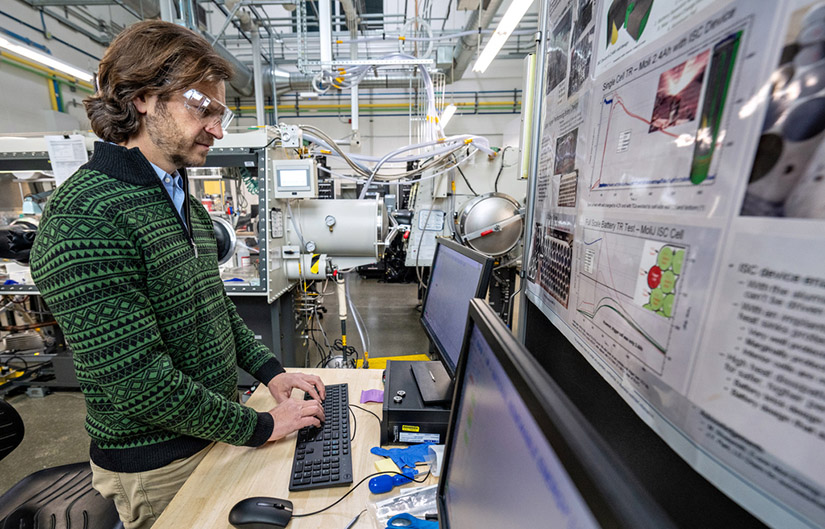Artificial Intelligence Models Improve Efficiency of Battery Diagnostics
NREL-Developed Neural Networks Uncover New Insights Into Battery Health

Resilient energy systems depend on reliable batteries. The lithium-ion (Li-ion) batteries powering our world must endure the steady strain of time, charge cycles, and environmental conditions that gradually wear them out through degradation.
Understanding the health of a battery can help manufacturers, researchers, and consumers alike optimize its lifetime performance. Yet diagnosing a battery’s state of health is no easy feat, as each cell is a complex system of chemical reactions and physical changes that standard evaluation models struggle to capture with speed and precision.
National Renewable Energy Laboratory (NREL) researchers have developed and demonstrated a groundbreaking physics-informed neural network (PINN) model that can predict battery health nearly 1,000 times faster than traditional models.
“Li-ion battery lifetime and aging dynamics vary significantly with chemistry, operating conditions, cycling demands, electrode design, and operational history, which makes optimal handling, design, and maintenance difficult,” said Kandler Smith, who leads electrochemical modeling and data science research at NREL. “It’s especially difficult to understand the physical degradation mechanisms of a battery during use without opening it up. We need reliable methods to check in on batteries’ internal state in a nondestructive way.”
NREL’s PINN replaces the traditional, resource-intensive battery physics model with a powerful artificial intelligence approach that mimics the interconnected neurons of our brains to analyze nonlinear, complex datasets. This deep learning process can enhance battery health diagnostics by quantifying physical degradation mechanisms and pave the way for more efficient, scalable approaches to manage battery aging.
Traditional Models and Limitations
NREL researchers have created a vast array of battery lifespan models to diagnose battery health, predict battery degradation, and optimize battery designs. For years, the team has been on the cutting edge of physics-based machine learning techniques to optimize predictive modeling for advanced battery research.
Two such models, the Single-Particle Model (SPM) and the Pseudo-2D Model (P2D), are widely used and accepted approaches to providing a window into how a battery’s internal health parameters—such as electrode inventory and kinetics, Li-ion inventory, and Li transport paths—evolve over time. However, directly using these models is an intensive process that requires massive amounts of computations and limits their ability to offer rapid diagnostics.
“Instead of a physics model, we proposed a PINN surrogate model to separate out a battery’s internal properties from its output voltage,” said NREL Computational Science Researcher Malik Hassanaly, who collaborated closely with the battery research team. “This approach drastically reduces the computational time and resources required, allowing researchers to quickly diagnose battery degradation and provide real-time feedback on battery health.”
The NREL-developed PINN surrogate combines the predictive power of artificial intelligence with the rigor of physics-based modeling. The resulting two-part study published in the Journal of Energy Storage demonstrates how researchers trained and tested the PINN surrogate using conventional SPM and P2D models. This multifaceted approach allowed NREL researchers to train the PINN surrogate on a wide range of internal battery properties. The resulting open-source model offers critical insights into changes that occur during battery aging, helping quickly estimate how long a battery might last in a different setting.
What makes this development especially revolutionary in battery research is the integration of physics-informed principles into neural networks. Traditional neural networks are data-driven models that excel at pattern recognition but often lack the ability to enforce physical laws, which are crucial for accurately simulating battery behavior. PINNs, however, are designed to understand and follow these physical laws by embedding them directly into the model’s training procedure, enabling it to predict battery parameters with a level of scientific rigor previously achievable only by complex, time-intensive models. With the PINN surrogate, techniques typically constrained by high resource requirements can now be applied on a broad scale, bringing real-time insights into battery health within reach.
Applications and Next Steps
The success of NREL’s PINN surrogate offers wide-ranging implications. For battery diagnostics, the PINN surrogate can provide rapid state-of-health predictions, allowing for faster decision-making across battery applications. By drastically lowering the computational barriers to battery diagnostics, the PINN surrogate model paves the way for widespread, scalable, and efficient energy storage management—helping ensure energy is available when and where it is needed.
“This approach unlocks new capabilities in battery diagnostics, paving the way for onboard diagnostics of batteries in use,” Smith said. “This means that batteries of the future may include systems to extend their useful life by identifying degradation signals and adapting fast-charge limits with age.”
Currently, researchers are working to transition the PINN surrogate from controlled simulations to real-work data validation, using batteries cycled within NREL’s laboratories. By bridging this gap, researchers hope to deploy PINN-based diagnostics across a wide range of battery systems, enhancing battery performance monitoring and extending lifespans. Future research will focus on refining the PINN model to handle highly dimensional problems, allowing it to predict a broader array of internal battery parameters with increased precision. This means creating models that can both respond to diverse current loads and scale effectively to future battery designs and usage patterns.
Learn more about NREL's energy storage and transportation and mobility research. And sign up for NREL's quarterly transportation and mobility research newsletter to stay current on the latest news.
Last Updated May 28, 2025
